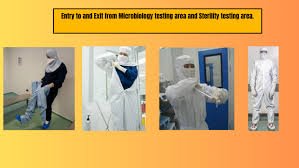SOP for Garment Change and Entry and Exit Through First and Primary Change Room

Standard Operating Procedure (SOP)
Here’s a comprehensive Standard Operating Procedure (SOP) for Garment Change and Entry/Exit Through First and Primary Change Rooms in a pharmaceutical manufacturing facility. This procedure ensures compliance with Good Manufacturing Practices (GMP) by preventing contamination and maintaining a controlled environment.
1. Objective
To establish a standardized procedure for personnel to change garments and enter or exit controlled areas via the first and primary change rooms, ensuring product integrity and compliance with GMP.
2. Scope
This SOP applies to all employees, visitors, contractors, and auditors accessing controlled areas such as manufacturing, sampling, dispensing, and packaging zones.
3. Responsibilities
-
All Personnel: Adhere to the gowning and degowning procedures as outlined.
-
Department Heads: Ensure team compliance and report any deviations.
-
Quality Assurance (QA): Monitor adherence and review documentation.
-
Production Manager: Oversee the implementation and maintenance of this SOP.
4. Procedure
4.1 Entry Procedure
A. First Change Room
-
Access: Enter through the designated entrance door.
-
Footwear: Remove outdoor shoes and place them in the designated rack or locker.
-
Personal Items: Remove personal belongings (e.g., watches, mobile phones, jewelry) and store them securely.
-
Cleanroom Footwear: Wear designated cleanroom footwear or shoe covers.
-
Hand Hygiene: Perform hand sanitization using the provided sanitizer or wash station.
-
Initial Garments:
-
Wear a hair net or cap, ensuring full coverage of hair and ears.
-
Wear a face mask covering the nose and mouth.
-
If applicable, wear a beard cover.
-
✅ Proceed to the Primary Change Room.
B. Primary Change Room
-
Zoning Compliance: Step over the bench or barrier as per zoning policy.
-
Gowning Sequence:
-
Wear a cleanroom gown or coverall.
-
If separate, wear a hood.
-
Wear goggles, ensuring clear visibility.
-
Don sterile gloves, ensuring proper technique and covering gown cuffs.
-
Wear booties or over-shoes as the last item before entering the cleanroom.
-
-
Self-Inspection: Inspect attire in the mirror to ensure proper gowning.
-
Final Check: Ensure garments do not touch the floor or walls.
✅ Enter the cleanroom through the designated door.
4.2 Exit Procedure
A. From Cleanroom to Primary Change Room
-
Entry: Step into the primary change room without touching outer surfaces.
-
Degowning Sequence:
-
Remove gloves and dispose of them in the biohazard bin.
-
Remove goggles, hood, and gown in that order, avoiding shaking.
-
Discard or place reusable items in the designated area (laundry bin or storage).
-
Remove booties and step over the bench.
-
B. From Primary to First Change Room
-
Garment Removal:
-
Remove face mask, hair net, and beard cover (if applicable).
-
Dispose of single-use items appropriately.
-
-
Footwear: Remove cleanroom footwear and place them in the designated area.
-
Hand Hygiene: Perform hand sanitization.
-
Personal Items: Retrieve personal belongings.
-
Exit: Leave through the designated exit door.
5. Color Coding of Uniforms
| Department/Role | First Change Room Attire | Primary Change Room Attire |
|---|---|---|
| Production/QA/QC/Office | White | Sky Blue (lint-free) |
| Engineering | Brown | Brown (lint-free) |
| Warehouse | Steel Grey | N/A |
| Visitors | Moss Green/Disposable | Sky Blue (lint-free) |
6. Precautions
-
Health: Personnel with illnesses or open wounds should report to their department head before entry.
-
Prohibitions: Eating, chewing, or bringing unauthorized items into controlled areas is prohibited.
-
Gown Integrity: Ensure gowns are intact and properly worn; report any damages immediately.
-
Behavior: Avoid unnecessary movements or conversations in changing areas to minimize contamination risks.
7. References
🎓 Discover one of the best Pharmaceutical Production courses available — click below to explore the course that’s shaping future Production skills.

